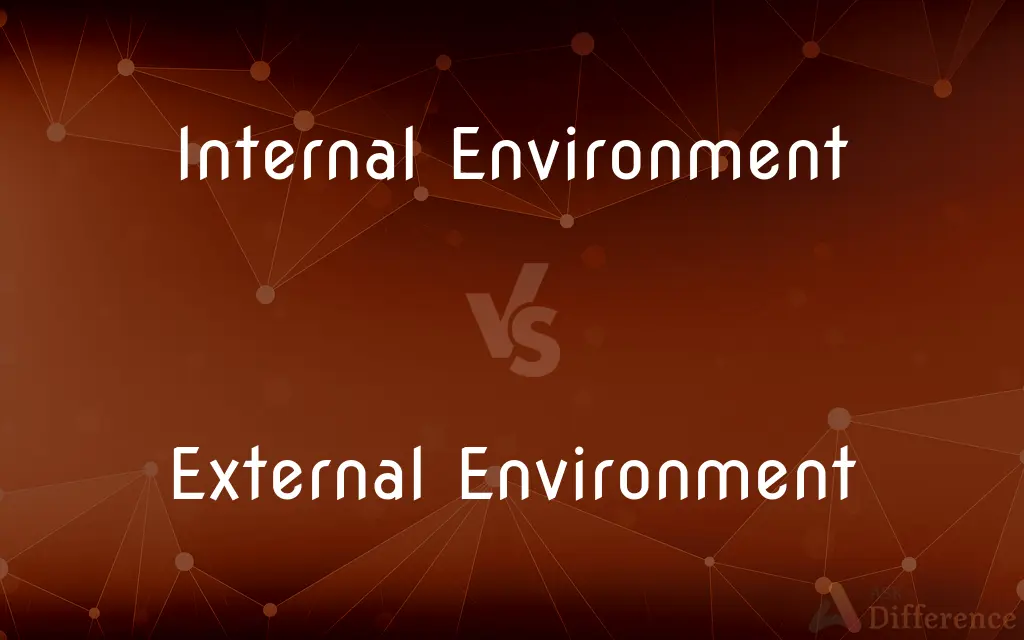Internal Environment vs. External Environment — What's the Difference?
By Tayyaba Rehman & Fiza Rafique — Published on October 14, 2023
Internal environment: comprises factors and conditions within an organization affecting its functioning. External environment: includes outside elements influencing the organization.

Difference Between Internal Environment and External Environment
Table of Contents
ADVERTISEMENT
Key Differences
The internal environment of an organization encompasses the conditions, factors, and forces within its organizational boundaries. This can include employee morale, organizational culture, management structure, and internal communication. The external environment, in contrast, is made up of the elements outside the organization that can impact its performance, such as economic conditions, competitors, and regulatory conditions.
An organization’s internal environment is often shaped by its human resources, management style, and company values. For example, a company with strong leadership, clear values, and open communication will likely have a healthy internal environment. The external environment, conversely, is shaped by market trends, customer demands, technology developments, and legal and social conditions that the organization has to navigate.
The internal environment is largely controllable and manageable by the organization since it is shaped by internal actors, such as employees and management. A positive internal environment may foster productivity, creativity, and employee satisfaction. However, the external environment is not controllable. Factors such as political instability, economic fluctuations, and social trends are beyond the organization’s control but can significantly impact its performance and strategic planning.
In a business context, understanding the internal environment is crucial for effective organizational management and decision-making, focusing on leveraging strengths and improving weaknesses. Understanding the external environment is equally crucial, as it helps organizations identify opportunities and threats in the marketplace and enables strategic positioning and responsive adaptation to external changes.
Both internal and external environments are critical for organizational success. A favorable internal environment promotes efficiency and goal attainment, whereas awareness and adaptability to the external environment ensure the organization’s survival and growth in the changing business landscape.
ADVERTISEMENT
Comparison Chart
Control
Largely controllable by the organization.
Not controllable by the organization.
Influence
Influenced by organizational members and culture.
Influenced by market conditions, laws, and trends.
Impact
Affects organizational functioning and culture.
Impacts organizational strategy and performance.
Management
Can be managed and improved internally.
Requires adaptation and response strategies.
Scope
Encompasses internal actors and conditions.
Encompasses external elements and conditions.
Compare with Definitions
Internal Environment
Internal environment: includes management structure and employee relations.
The internal environment was strengthened by supportive leadership.
External Environment
Includes market trends, economic conditions, and competitors.
The turbulent external environment poses challenges to organizational stability.
Internal Environment
Internal environment: the realm of controllable organizational elements.
The company's internal environment has been destabilized by poor communication.
External Environment
Encompasses outside factors impacting an organization.
Changes in the external environment necessitated a shift in business strategy.
Internal Environment
Internal environment: conditions and factors within an organization.
A positive internal environment fosters employee satisfaction.
External Environment
Encompasses societal, legal, and political conditions impacting an organization.
Adapting to the external environment is crucial for business survival.
Internal Environment
Internal environment: encompasses organizational culture and morale.
A cohesive internal environment is essential for productivity.
External Environment
Refers to external dynamics and conditions influencing organizations.
Understanding the external environment is key to strategic positioning.
Internal Environment
Internal environment: comprises the internal dynamics influencing organizational behavior.
The innovative internal environment propelled the company forward.
External Environment
Comprises uncontrollable elements affecting organizational performance.
A favorable external environment can offer numerous business opportunities.
Common Curiosities
Can organizations control their external environment?
No, organizations cannot control but must adapt to their external environment.
What defines the internal environment of an organization?
It is defined by the conditions, factors, and forces within an organization’s boundaries.
What elements constitute the internal environment?
Elements like organizational culture, employee morale, management structure, and internal communication constitute the internal environment.
Is the external environment only about market conditions?
No, it also includes economic, legal, social, political, and technological conditions.
How does the external environment affect small businesses?
Small businesses are often more vulnerable to changes in the external environment due to limited resources and scale.
How does the external environment impact organizational strategy?
It shapes organizational strategy by presenting opportunities and threats that require strategic positioning and response.
Can organizations change their internal environment?
Yes, organizations can manage and improve their internal environment through interventions like organizational development.
How can organizations adapt to a volatile external environment?
By being proactive, developing flexible strategies, and constantly monitoring external changes, organizations can adapt effectively.
Are employees part of an organization's internal environment?
Yes, employees are a crucial component of the internal environment, influencing and being influenced by it.
How does the external environment differ from the internal environment?
The external environment includes outside elements influencing the organization, unlike the controllable internal environment.
Is the internal environment more important than the external environment?
Both are equally important; a favorable internal environment promotes efficiency, while adaptability to the external environment ensures survival and growth.
Why is understanding the internal environment crucial?
It is crucial for effective management, decision-making, and improving organizational strengths and weaknesses.
How can an unfavorable external environment be mitigated?
Through risk management, diversification, and development of adaptive strategies, organizations can mitigate the impact of an unfavorable external environment.
What role does leadership play in shaping the internal environment?
Leadership plays a pivotal role in shaping organizational culture, morale, communication, and overall internal environment.
Do internal and external environments influence each other?
Yes, changes in one can significantly impact the other, affecting organizational performance and strategy.
Share Your Discovery

Previous Comparison
On Time vs. In Time
Next Comparison
Static Friction vs. Kinetic FrictionAuthor Spotlight
Written by
Tayyaba RehmanTayyaba Rehman is a distinguished writer, currently serving as a primary contributor to askdifference.com. As a researcher in semantics and etymology, Tayyaba's passion for the complexity of languages and their distinctions has found a perfect home on the platform. Tayyaba delves into the intricacies of language, distinguishing between commonly confused words and phrases, thereby providing clarity for readers worldwide.
Co-written by
Fiza RafiqueFiza Rafique is a skilled content writer at AskDifference.com, where she meticulously refines and enhances written pieces. Drawing from her vast editorial expertise, Fiza ensures clarity, accuracy, and precision in every article. Passionate about language, she continually seeks to elevate the quality of content for readers worldwide.
















































